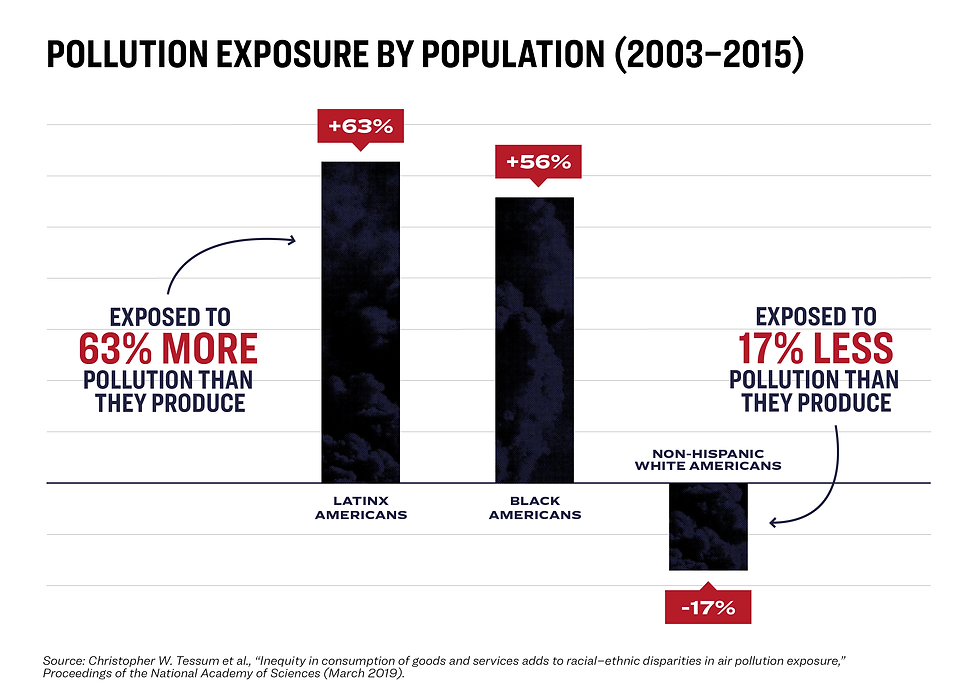What is Environmental Racism?
- Megan at ZeroSmart
- Dec 8, 2022
- 4 min read
Definition
Environmental racism is a form of systemic racism whereby communities of colour are disproportionately affected by (whether it is intended or unintended) health hazards through policies and practices, that force them to live in proximity to sources of toxic waste such as sewage works, mines, landfills, power stations, major roads and emitters of airborne particulate matter. As a result, these communities suffer greater rates of health problems attendant on hazardous pollutants.
The term environmental racism was coined by African American civil rights leader Benjamin Chavis in 1982. He described it as “racial discrimination in environmental policy-making, the enforcement of regulations and laws”.
A 2018 study by Environmental Protection Agency scientists found that people of colour on average faced a 28 percent higher health burden compared to the general population thanks to living in proximity to facilities emitting particulate pollution like soot. For Black Americans, the findings were especially troubling, with a 54 percent greater health burden reported.
A landmark 2007 study by academic Dr Robert Bullard proved that African American children were five times more likely to have lead poisoning from proximity to waste than Caucasian children, while even black Americans making $50-60,000 a year were more likely to live in polluted areas than their white counterparts making $10,000. In the UK meanwhile, a government report found that black British children are exposed to up to 30% more air pollution than white children.
Examples of environmental racism
Environmental racism is a global issue, with examples seen across the globe. One case which shocked headlines across the globe is the case of Poisoned tap water in Flint, Michigan.
Poisoned tap water in Flint, Michigan.
In the Spring of 2014, Flint, Michigan, planned to join a new regional system, and while it waited for it to be built, it began bringing in its water from the Flint River. After this switch, the town grew alarmed at the water that flowed from their kitchen taps and showerheads. The pastor of the town recalls: “The water was coming out dark as coffee for hours”, McCathern remembered. He recalls the shock getting rising hin his throat, “Something is wrong here.”
Despite the town curating packed public meetings, writing questioning letters and protesting at the city hall, they were repeatedly told the water was fine. Authorities recommended only to leave the taps on for a few minutes before using the water, to get a clean flow. State environmental officials continue to say again and again that there was nothing to worry about.
But this wasn't the case.
The reason the water was the same colour as coffee is because the water was full of corroded iron. This rapidly corroding iron meant that the chlorine treatment of the water was ineffective. Without the disinfectant, the water was vulnerable to bacteria growth. The first of the E/. coli bacteria infections had come a few months after the switch. To combat it, more chlorine was added to the water. As the corrosion worsened, lead leached into the water. No amount of lead exposure is safe, and there is no known cure for lead poisoning. The excess iron also turned out to be a perfect nutrient for the growth of other types of bacteria, including legionella, which causes a virulent form of pneumonia called Legionnaires’ disease.
Over two years, an outbreak of the disease affected at least 90 people and killed 12. And, according to one research team, the water switch correlated with a serious drop in fertility for women in Flint and a 58% increase in foetal deaths.
Flint is already a vulnerable population: Only 100,000 people live there, a majority of whom are African-American, and about 45 percent of its residents live below the poverty line. Nearly one in six of the city’s homes has been abandoned.
What Can We Do?
Like most issues, one of the most powerful and effective things we can do is educate ourselves and those around us.
There are many other high profile environmental racism cases, including Toxic waste dumps in the Lower Rio Grande Valley and a town in China where 80% of children have been poisoned by old computer parts. Spreading awareness is paramount. Take the time to read the above articles to gather more of an insight of what happens. Share this article to those around you, who also care about these issues.
When researching Environmental Racism case studies, something which comes up time and time again is e-waste. Read our blog on e-waste, its causes and its harmful effects.
In 2019, a now very famous film “There’s Something in the Water” was released. This eye opening, terrifying film is an amazing insight into this prolific issue.
There are campaigns, meetups, documentaries, petitions all out there, run by people who are fighting to make a difference. Could you be one of these people?
Please like, comment and follow our Instagram for not only more content like this, but also to help us spread our message. The more of us there are, the louder we can shout.




















